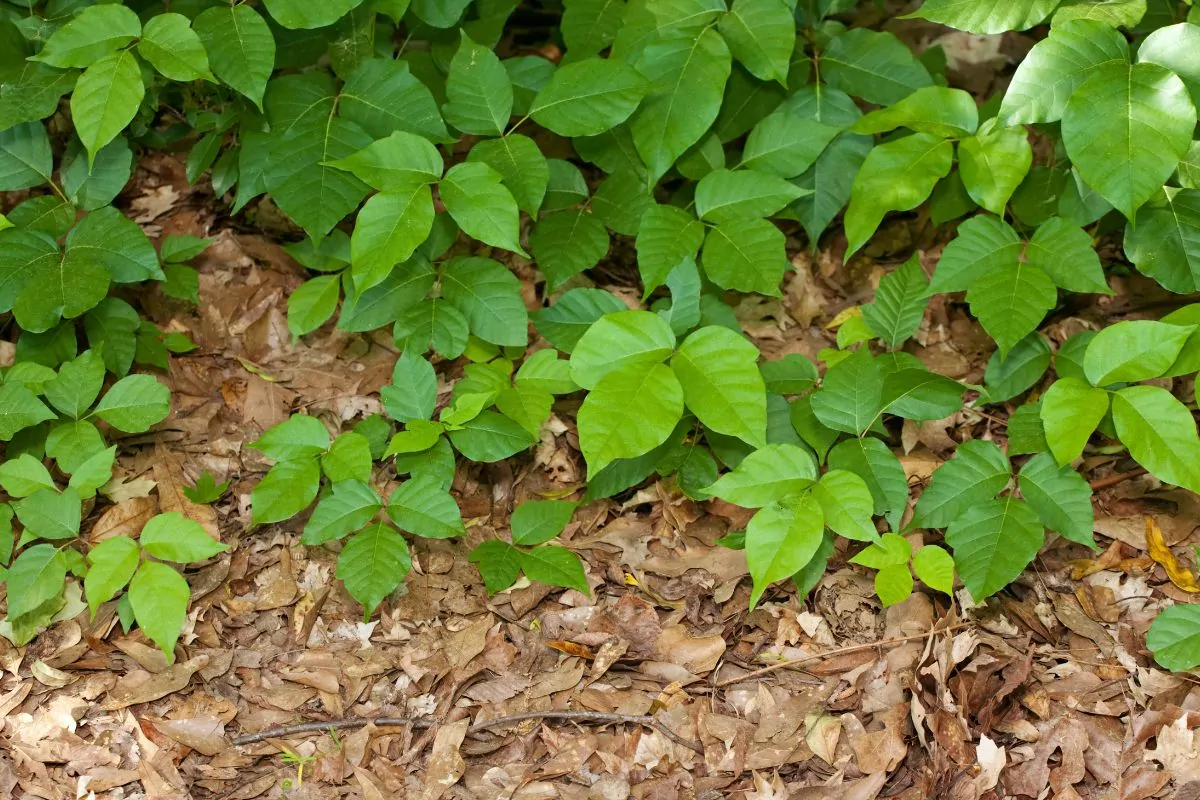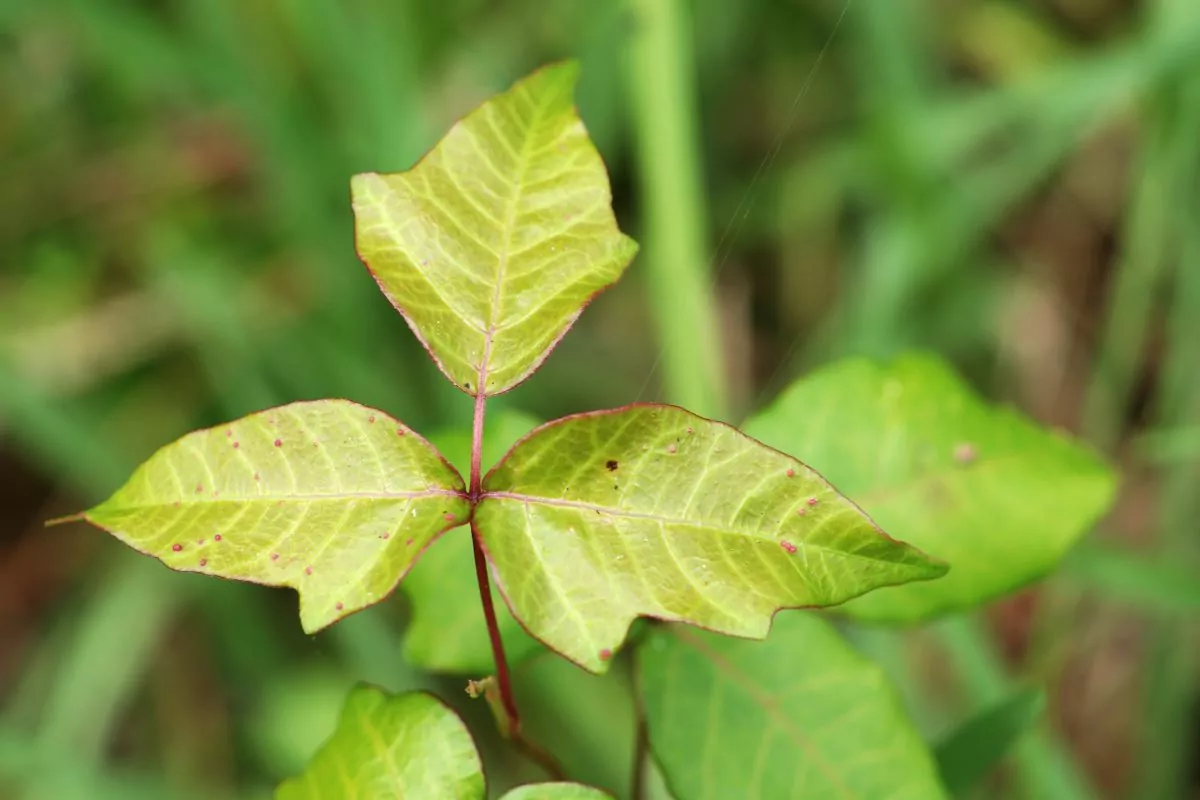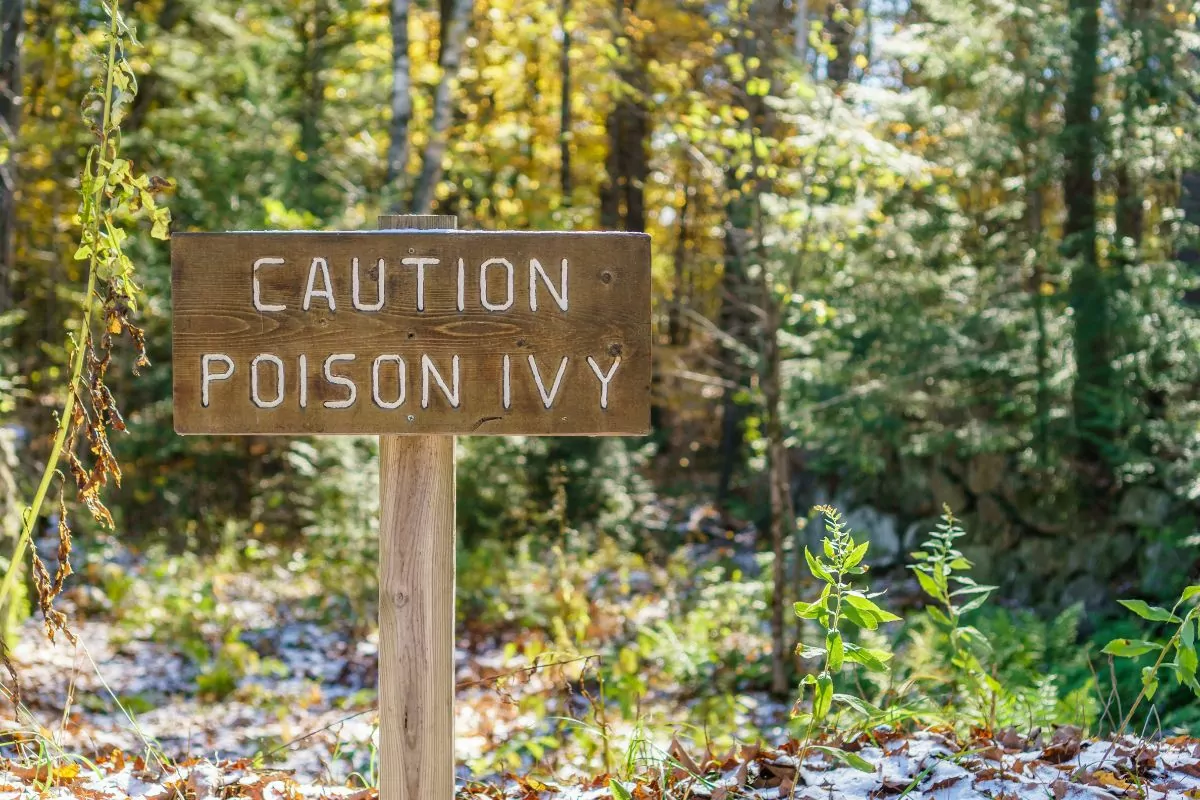Can dogs get poison ivy? What are the symptoms in dogs? Can I get poison ivy from my dog? Poison ivy on dogs can concern owners. Read on to the end as we will give you all the guidelines for treating and preventing poison ivy discomfort in your best friend!
What is Poison Ivy?
Poison ivy (Toxicodendron radicans) is a common plant in North America. It grows in open fields, wooded areas, roadsides, parks, and urban areas. The part of poison ivy that causes problems is its sap, which contains Urushiol oil. Poison ivy grows as shrubs or vines clinging to any support, distinguished by its three serrated green leaf clusters. A good way to remember what poison ivy looks like is the rhyme: “Leaves of three, let them be.” (author unknown, n.d).

How Can You Tell if Your Dog Has Poison Ivy?
The most common condition for dogs and humans is allergic dermatitis on the skin. Transmission can be by direct contact with Urushiol oil from the plant. Or indirect contact because the irritating oil persists on the objects it was in touch with for a long time.
Do you have a dog with a lot of hair? The good news is that the shaggier your dog is, the more natural protection it has against poison ivy. The fluffy, thick fur protects a dog’s skin from coming into contact with the plant’s oils.
Some dog breeds have a higher risk of poisoning due to less hair, for example:
- American Hairless
- Chinese Crested
- Hairless Khala
- Peruvian Inca Orchid
- Xoloitzcuintle
Especially susceptible body areas of any canine to Urushiol oil include:
- Groin
- External genitalia
- Muzzle
- Armpits
And any other area with less hair and more exposed skin.
What does poison ivy look like on dogs? The symptoms usually appear within the first 24 hours to three days after exposure. Signs of an allergic reaction to poison ivy in dogs are:
- Swollen, hot, and red skin
- Blisters
- Crusting
- Itching that manifests with increased scratching and licking
If the condition progresses, there will also be fever, lack of appetite, and lethargy.
What Happens if a Dog Licks Poison Ivy?
Dogs are at risk if they lick the oil off their fur or have the habit of sniffing and eating everything they find during their walks.
If a dog ingests poison ivy sap, it may manifest vomiting and diarrhea due to irritation of its digestive tract.
Severe cases of poison ivy ingestion present an intense anaphylactic reaction. Pay attention to the symptoms:
- Abdominal pain
- Anxiety and salivation
- Generalized swelling
- Generalized itching
- Respiratory distress
Although very rare, anaphylactic shock is the most severe case of poison ivy. It is a veterinary emergency and requires immediate medical attention.
How Long Does Poison Ivy Last on Dogs?
Symptoms usually develop within 24 hours of exposure and last two to three weeks.
Lesions on dogs usually resolve without medical treatment and do not leave scars.
If the dog scratches or licks, the skin blisters can rupture and become infected. Secondary bacterial infections need antibiotic treatment and will take longer to heal.

How to Treat Poison Ivy on Dogs
If your dog comes in contact with poison ivy or returns from a walk with an oily coat, don’t wait for symptoms to appear. You can take a simple but big step to soothe your friend: bathe it!
How to get rid of poison ivy on dogs? Remember that Urushiol oil is difficult to remove. So, here we will give you the indications you need to bathe your best friend and not get intoxicated in the attempt:
- Wear waterproof rubber gloves and clothing with long sleeves and pants
- Be sure to wash any towels or rags immediately you use to dry your dog with very hot water
- It is better to use cold water rather than warm water to reduce inflammation
- Counteract the Urushiol oil with an oat-based (hypoallergenic) dog shampoo
- Do not rub your eyes. Use some kind of goggles to avoid accidents.
- Remember to wash the collar and leash. All your effort will not make sense if you do not clean all the objects in contact with your canine.
Watch your dog for a week after the exposure to ensure no skin rashes develop. During this week, the dog must not come in contact with furniture, people, and other animals.
If cutaneous symptoms appear, you must visit your veterinarian for treatment.
To treat poison ivy rash on dogs, some suggestions are:
- Place cold, wet compresses on the affected area for 15 to 30 minutes daily. These compresses and a fan will help keep the affected areas cool and relieve itching and pain
- To reduce itching, apply cortisone cream or ointment for the first few days
- Over-the-counter skin protectants like calamine can dry out, oozing rashes
- Home remedies include placing plantain leaves, aloe vera, or cucumber slices on lesions
- Over-the-counter oral antihistamines are also a good option for reducing itching
- If secondary bacterial contamination occurs, your veterinarian will prescribe oral antibiotics
If your dog has ingested the plant and digestive symptoms appear, visit your veterinarian for a check-up. Symptomatic treatment. It is necessary when gastrointestinal discomfort is severe based on the following:
- Intravenous hydration
- Antiemetics
- Vitamin supplements
- Antibiotic therapy
- A diet based on moist food
Can Dogs Get Poison Ivy on Their Nose?
An itchy rash, constant sneezing, and clear signs of desperation are symptoms of poison ivy on dogs’ noses. Also, intense itching. The nose is a hairless area exposed to Urushiol oil in dogs that sniff during their walks.
Can Dogs Get Poison Ivy on Their Tongue?
Dogs may experience irritation of the tongue and other parts of the mouth when licking, chewing, or eating the poison ivy plant. Discomfort will arise from the itching caused by this irritation. Fortunately, it is scarce for dogs to eat shrubbery!
How Does Poison Ivy Affect Dogs?
Urushiol oil generates an allergic-type immune reaction. The dog’s skin releases histamine to get rid of the oil. Histamine cannot remove the oil, but it does trigger intense itching.
Since it is an allergic reaction, each individual’s response is different. Generally, most dogs do not develop an exaggerated reaction to poison ivy. The symptoms self-limit in approximately two to three weeks. A minority of canines have a more intense but not life-threatening reaction. Only a tiny percentage of dogs exposed generate a severe, life-threatening reaction.
How to Prevent Poison Ivy in Canines
The best way to prevent poison ivy from affecting your dog is to limit his exposure to it. So,
- Wear a collar and leash during walks
- Avoid areas where poison ivy is present.
- If you suspect your dog has had contact with poison ivy, bathe him immediately.
- Remove poison ivy from your yard.
Tips for identifying poison ivy bushes:
- Leaves have three almond-shaped leaflets
- Leaves range from light green (young) to dark green (mature leaves), changing to red when they are about to fall
- The leaves range from 1.18 to 4.72 in (3 to 12 cm) long, rarely reaching 11.18 in (30 cm), with a serrated edge and a smooth surface
- The fruits (drupes) are grayish and are a favorite food for some birds in winter.
To remove poison ivy from your garden, you can hire a professional or, if you wish, you can do it yourself by following the tips below:
- It will take more than one or two attempts to remove it completely
- Identify the plants you want to eliminate, but if you clear out non-toxic plants, there will be more room for poisonous plants.
- Appropriate dress: Wear gloves. Cover all exposed skin with proper clothing to protect your extremities. Use rubber boots. Wear goggles and a respirator.
- Work in good weather: Do not work on a very hot or windy day
- The best time to remove weeds is before flowering and fruiting. Otherwise, controlling them can be very difficult. After they have flowered and fructified, their seeds can spread very fast
- Pulling: If the soil is too dry, water it to soften. After that, prune or cut the plants to the ground and pull out the roots. Then place all debris and foliage in heavy garbage bags
- Treat the affected area: Use an herbicide on the remaining poison ivy foliage. Keep it away from any plants you don’t want to kill
- Do not burn poison ivy. The toxins released are irritating to the respiratory system.
Can Dogs Spread Poison Ivy to Humans?
Urushiol can attach itself to a dog’s coat. The owner may contact the oil through the following:
- Dog’s paws touching the owner’s skin
- Dog’s owner petting the dog
- Dog rubbing its skin against its owner’s bare arm or leg
Unlike dogs, most people only need a small amount of Urushiol to develop an allergic reaction. When exposed to 1.76 oz (50 mcg) of the oil, an amount that is less than one gram of table salt, 80 to 90% of people develop a rash.
The liquid from the blisters is not contagious. Urushiol does not spread. Skin irritation may worsen during the first few days due to chemical compounds released by the person’s body.

Final Words
Although exposure to poison ivy is not a death sentence for your dog, it can have uncomfortable side effects. If you take the indicated preventive measures and keep an eye on your dog’s environment, you can protect him from the painful effects of poisonous plants.
